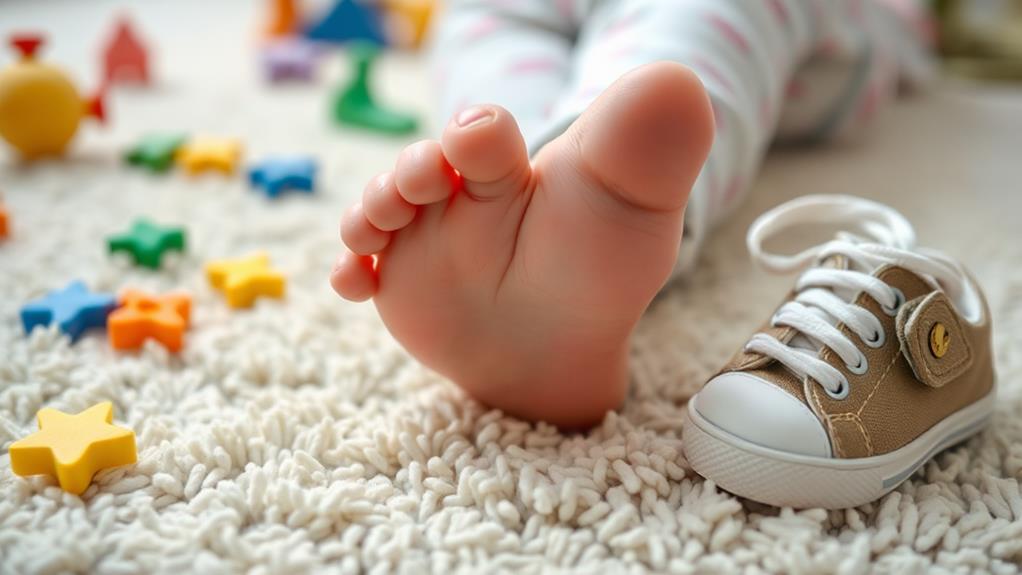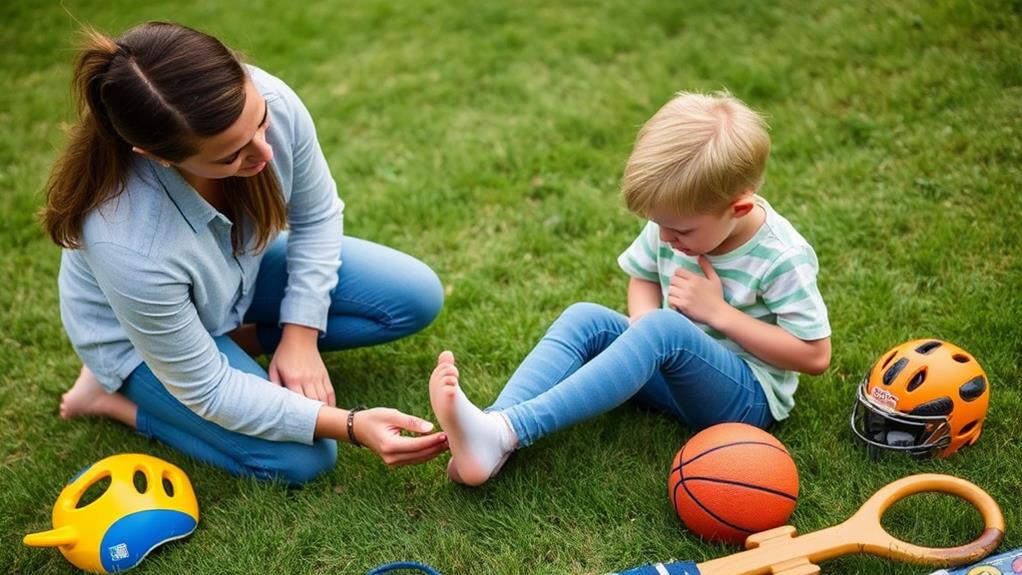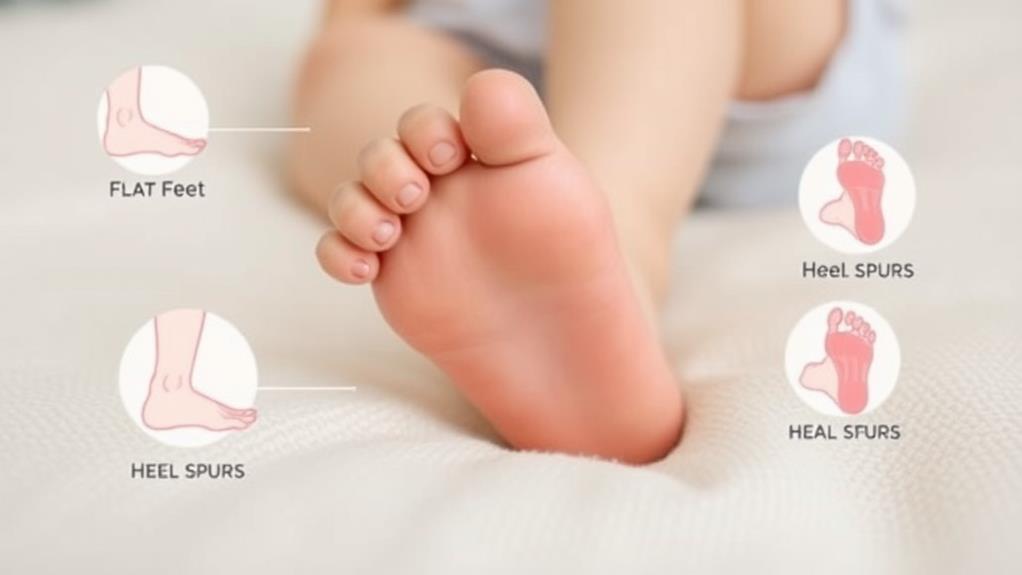Why Do Kids Have Heel Pain? Common Causes Explained
If you've noticed your child complaining about heel pain, you might wonder what's causing this discomfort. It could stem from various factors, such as growth spurts, overuse from their active lifestyle, or even improper footwear. Conditions like Sever's disease or flat feet can also play a role in straining their muscles and ligaments. Understanding these common causes can help you take the right steps toward relief, but what should you do first to ensure your child's foot health?
Understanding Heel Pain

Heel pain in kids can be concerning, especially when it disrupts their playtime and activities. You might wonder why your child is experiencing this discomfort, and understanding the causes is the first step to finding relief.
Heel pain often arises from conditions like Achilles tendonitis or plantar fasciitis, both of which can be triggered by overuse or improper footwear.
It's important to pay attention to their activity levels, as kids are naturally energetic and may push themselves too hard during sports or play. If your child complains about pain after running, jumping, or even just standing for long periods, it could be a sign that their heels need some attention.
Additionally, the growth plates in their heels are still developing, making them more susceptible to injury. It's crucial to ensure they wear supportive shoes that fit well, as this can significantly reduce the risk of heel pain.
If the pain persists, it might be time to consult a healthcare professional. By understanding heel pain and addressing it early, you can help your child get back to enjoying their favorite activities in no time!
Growth Spurts and Heel Pain
During periods of rapid growth, kids often experience various aches and pains, including discomfort in their heels. This heel pain is frequently linked to growth spurts, a natural part of childhood development. As bones grow, the tendons and ligaments around them may struggle to keep up, leading to tightness and inflammation.
You might notice that your child complains more about heel pain during these times, especially if they're active in sports or running around. The growth plates in their heels, known as the calcaneal apophysis, can become irritated as they grow. This irritation can feel like a sharp or throbbing pain, especially after a long day of activity.
It's important to pay attention to these signs. Encouraging your child to rest, ice the affected area, and wear supportive footwear can really help. Stretching exercises may also ease some discomfort.
While this pain can be concerning, it typically resolves as their body adjusts to the rapid changes. Understanding that growth spurts are a normal part of development can help both you and your child navigate these uncomfortable times more easily.
Common Injuries in Children

Children are naturally active, which often leads to a variety of common injuries. As they run, jump, and play, they may experience sprains, strains, or even fractures. One of the most frequent injuries is an ankle sprain. This happens when a child twists their ankle, causing the ligaments to stretch or tear. You might notice swelling, bruising, or difficulty walking.
Another common injury is a growth plate fracture, which affects the area where bones grow. This can occur in the heel or other long bones, especially during those rapid growth spurts. It's crucial to pay attention if your child complains of pain in these areas.
Tendonitis is also something to watch for, particularly in active kids. Overuse of the Achilles tendon, located at the back of the ankle, can lead to discomfort and inflammation.
Lastly, consider heel contusions, which occur from direct impacts, like a fall or bump. These can cause bruising and pain, making it hard for your child to walk comfortably.
Being aware of these common injuries can help you address any concerns quickly and keep your child active and healthy!
Activities Leading to Discomfort
Many kids don't realize how certain activities can lead to heel discomfort until they start experiencing pain. Whether it's running on the playground, jumping during basketball practice, or dancing in a recital, these fun activities can sometimes put too much strain on your heels.
When you engage in high-impact sports or even just play hard with friends, your feet take a beating. Wearing the wrong shoes can also contribute to heel pain. If your sneakers lack support or cushioning, that extra pressure can really hurt.
Additionally, not warming up properly before vigorous activities can lead to muscle tightness or overuse injuries, which can manifest as heel discomfort. If you're involved in sports that require a lot of running or jumping, like soccer or gymnastics, paying attention to your body is key.
Listen to its signals; if your heels start to hurt, it's a sign you may need to take a break or adjust your routine. Remember, it's cool to take care of your feet! By being mindful of the activities you choose and how you prepare for them, you can keep heel pain at bay and enjoy all the fun that comes with being active.
Developmental Conditions to Consider

Heel pain in kids can sometimes stem from underlying developmental conditions that may not be immediately obvious. One such condition is Sever's disease, which occurs when the growth plate in the heel becomes inflamed. This typically affects active kids aged 8 to 14, especially those involved in sports. You might notice your child complaining of pain during or after physical activities.
Another condition to consider is Osgood-Schlatter disease. While it primarily affects the knee, it can lead to compensatory changes in walking and running that may impact the heels. This condition is often seen in adolescents who are experiencing growth spurts.
Flatfoot is another developmental aspect to think about. While we'll discuss it in more detail later, it can contribute to heel pain due to the lack of support for the arch.
It's essential to pay attention to your child's complaints and any accompanying symptoms. If you suspect a developmental condition, consulting a healthcare professional is crucial. They can provide a proper diagnosis and recommend the best course of action to help your child find relief and stay active.
Flat Feet and Their Impact
When it comes to flat feet, the lack of an arch can significantly impact a child's overall foot mechanics and lead to discomfort, including heel pain.
Flat feet mean that the foot doesn't have the typical arch, which helps in distributing weight evenly while walking or running. When your child has flat feet, the muscles and ligaments work harder to stabilize the foot, leading to fatigue and discomfort.
This extra strain can cause pain not just in the feet, but also in the ankles and even up to the knees and hips. It's essential to pay attention if your child often complains about soreness after activities.
Kids with flat feet might also find it challenging to participate in sports or play, as the discomfort can limit their movement.
Regular check-ups are crucial, as a healthcare professional can assess your child's foot structure and recommend appropriate exercises or treatments.
Encouraging your child to stretch and strengthen their foot muscles can also help relieve some of the pressure.
The Role of Footwear

Choosing the right footwear plays a crucial role in managing heel pain in kids. Well-fitted shoes can provide the support your child needs, helping to alleviate discomfort. When selecting shoes, look for those with cushioning and arch support. This is especially important if your child has flat feet or high arches, as these conditions can contribute to heel pain.
Avoid shoes that are too tight or too loose, as both can lead to issues. Shoes with a stiff heel counter can offer additional stability, while flexible soles allow for natural movement.
It's also wise to steer clear of flip-flops and high heels, which often lack the support needed for active kids.
Regularly check the fit of your child's shoes, as their feet grow quickly. If you notice signs of wear or if the shoes seem uncomfortable, it's time for a new pair.
Remember, the right footwear can make a significant difference in your child's comfort and activity level. By investing in quality shoes, you're not just protecting their feet; you're also helping them enjoy their favorite activities without the burden of heel pain.
When to Seek Medical Advice
If your child experiences persistent heel pain that doesn't improve with rest or proper footwear, it's important to seek medical advice. Ignoring the issue can lead to further complications, so don't hesitate to consult a healthcare professional.
Look for signs that indicate it's time to act. If your child has difficulty walking, limps, or expresses discomfort during regular activities, these are red flags that shouldn't be overlooked.
Additionally, if the heel pain is accompanied by swelling, bruising, or tenderness, it's a good idea to get it checked out. You know your child best, so trust your instincts—if something feels off, it probably is.
A doctor can help identify the underlying cause of the pain, whether it's a growth-related issue like Sever's disease or an injury from sports.
Early intervention is key to preventing long-term problems, and your child deserves to be pain-free. Remember, seeking help is a proactive step toward ensuring your child's overall health and well-being.
The sooner you address the issue, the sooner they can get back to enjoying their favorite activities without discomfort.
Tips for Managing Pain

Managing your child's heel pain effectively can make a significant difference in their comfort and daily activities. Start by encouraging rest; avoiding high-impact activities can help reduce pain.
Ice therapy is another great tool—apply an ice pack for 15-20 minutes several times a day to lessen swelling and discomfort.
Make sure your child's footwear is supportive and properly fitted. Shoes with cushioning can absorb shock and ease pressure on the heels. You might also consider adding arch supports or insoles for extra comfort.
Stretching exercises can play a vital role too; gentle calf stretches and toe raises can improve flexibility and strength, aiding in pain relief.
If your child experiences pain after activities, remind them to take breaks and listen to their body. Keeping a pain diary can help track triggers and improvements, providing valuable insights for both you and your healthcare provider.
Lastly, don't hesitate to consult a medical professional if the pain persists or worsens. By following these tips, you can help your child manage their heel pain effectively and get back to enjoying their favorite activities!













Post Comment